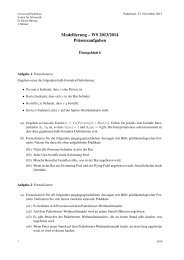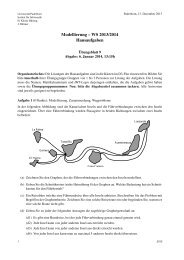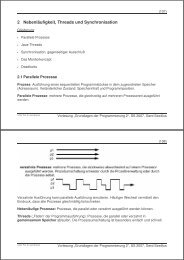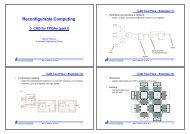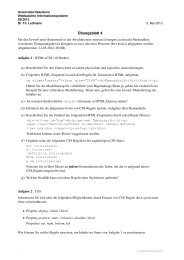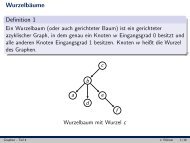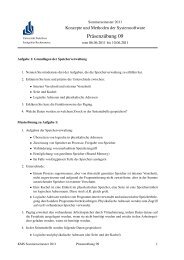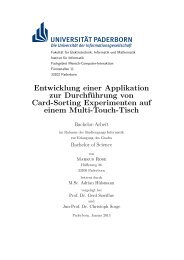User Modeling human-computer interaction
User Modeling human-computer interaction
User Modeling human-computer interaction
You also want an ePaper? Increase the reach of your titles
YUMPU automatically turns print PDFs into web optimized ePapers that Google loves.
1 Introduction<br />
Novels are the best source for new concepts in <strong>computer</strong> science, because they show us<br />
visions for the evolution of new ways in using <strong>computer</strong> systems. A good example of<br />
such a novel is from Arthur C. Clarke: 2001 - A space odyssey which was filmed in a<br />
movie by Stanley Kubrick in 1968. In this movie we can see the board <strong>computer</strong> from<br />
the spaceship ”Discovery” called HAL9000. Some of his features are the recognition of<br />
different users and the adaption of his user interface to each individual user. I think<br />
this shows us the potentiality in the research of the <strong>interaction</strong> of <strong>human</strong>s and <strong>computer</strong><br />
systems.<br />
So what we are looking for in this paper is a way to personalize <strong>computer</strong> systems.<br />
That means the <strong>computer</strong> system can be adapted or adapt automaticly to the needs of<br />
each individual user. To facilitate this, we have to collect some information about the<br />
users and develop a user model with this informations.<br />
Before we can think about a way to personalize a <strong>computer</strong> system, we have to talk<br />
about some basics in <strong>human</strong>-<strong>computer</strong> <strong>interaction</strong> (HCI) and user modeling (UM). In<br />
the next section we take a look at the tools to build a model of a user with the UM-<br />
Shellsystems. The last section is about the difficulties in the design of personalized<br />
<strong>computer</strong> systems and the difference between adaptive and adaptable systems. At the<br />
end there will be a short summary of what we have found out in this paper.<br />
2 Basics<br />
First we must talk about some basics about <strong>human</strong>-<strong>computer</strong> <strong>interaction</strong> and user modeling.<br />
2.1 Human-<strong>computer</strong> <strong>interaction</strong> (HCI)<br />
Let us begin with a definition of <strong>human</strong>-<strong>computer</strong> <strong>interaction</strong>:<br />
”Human-<strong>computer</strong> <strong>interaction</strong> is a discipline concerned with the design, evaluation<br />
and implementation of interactive computing systems for <strong>human</strong> use<br />
and with the study of major phenomena surrounding them.” ([Per96])<br />
As we will see the study of phenomena around the use of interactive <strong>computer</strong> systems<br />
gets more and more important in the last few years. When we take a look at the research<br />
in HCI we can see that there where 3 main stages in the history of research.<br />
3 stages in HCI research In the first stage the primary intention was the design<br />
of graphical user interfaces (GUIs) using windows, icons etc. to create more usable<br />
systems. The next step in the research of HCI was the question, how the people use<br />
the interfaces and components of a <strong>computer</strong> system. So that the actions not just the<br />
interfaces were focused in this stage of research. Today we want to improve the way<br />
people use <strong>computer</strong>s to work and communicate with.<br />
3





